The principles of providing safety of population and
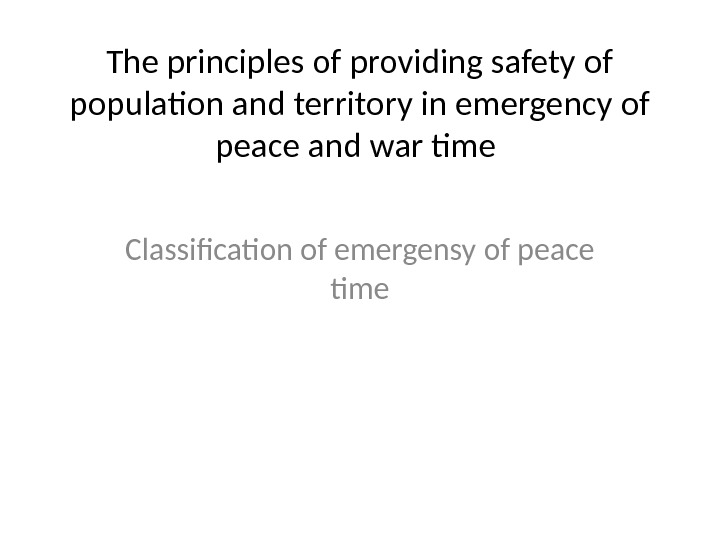
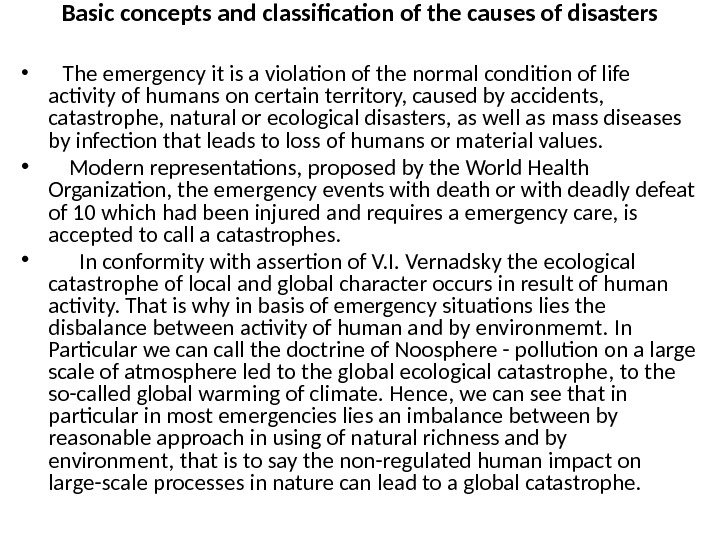
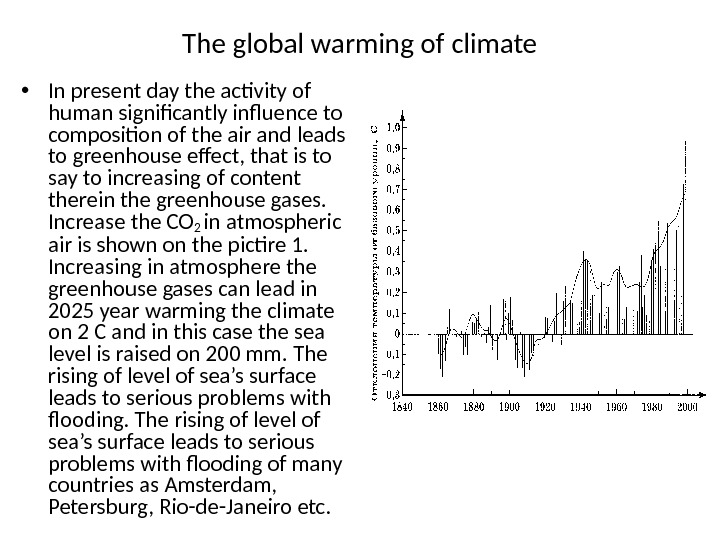
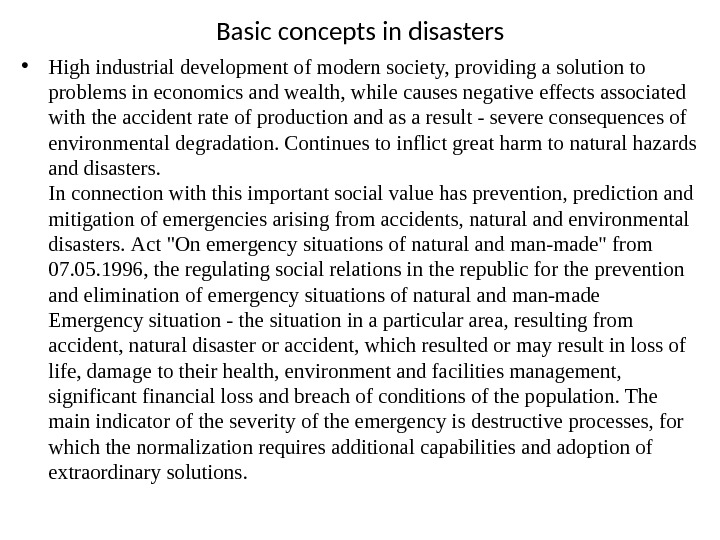
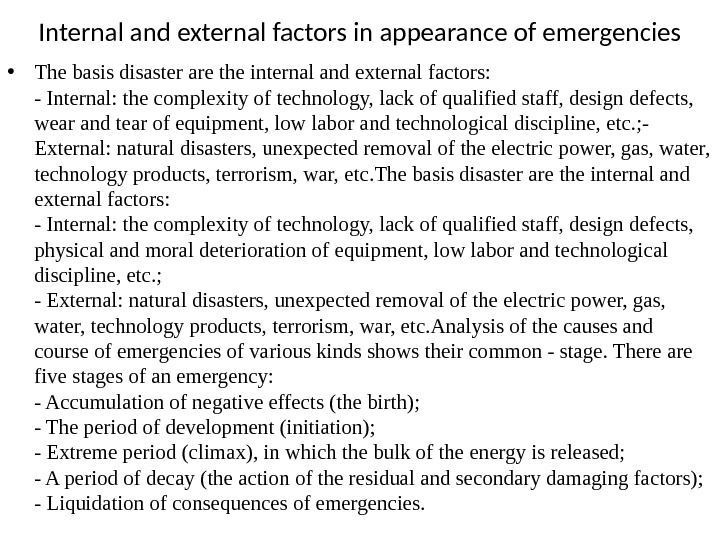
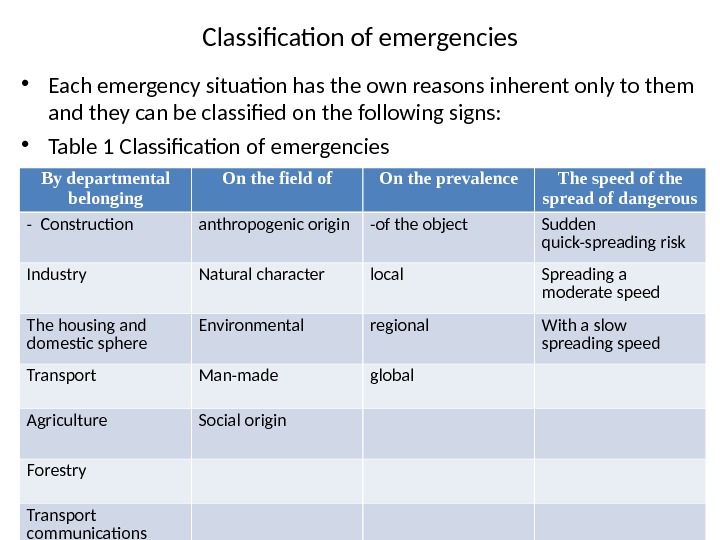
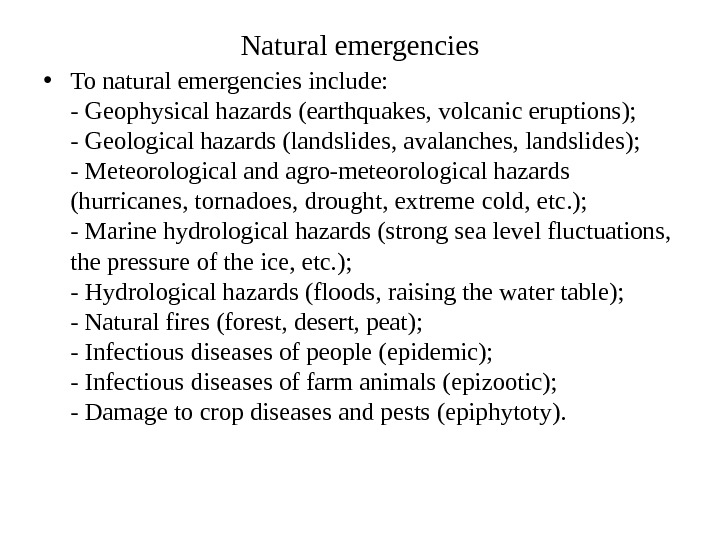
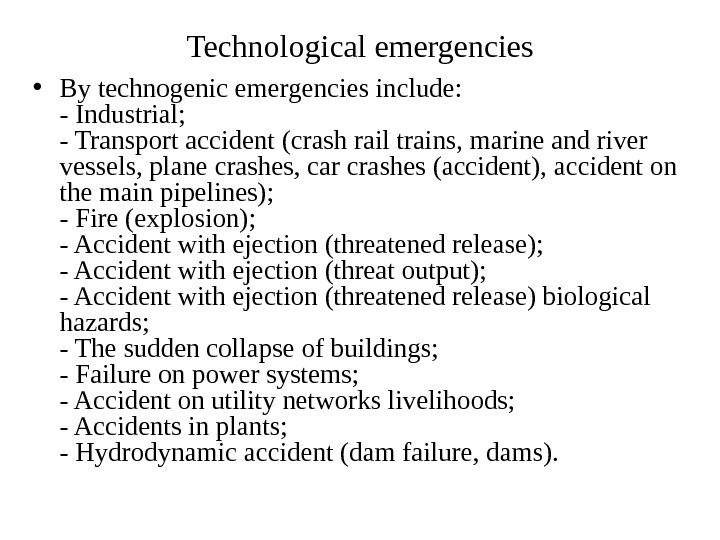
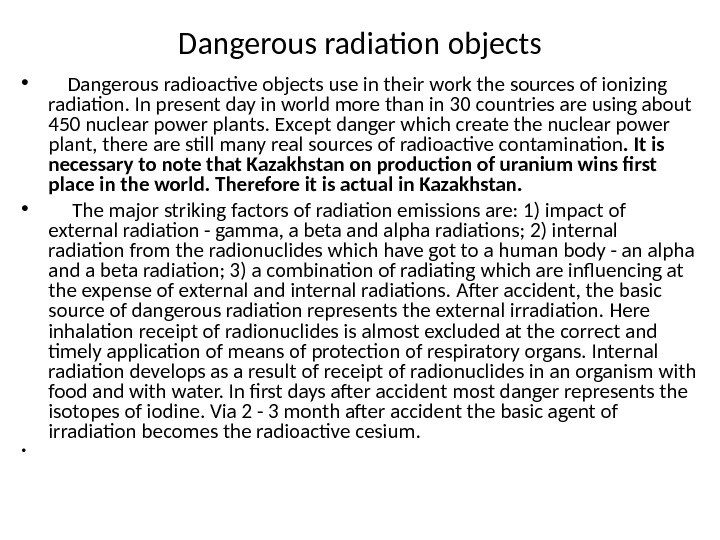
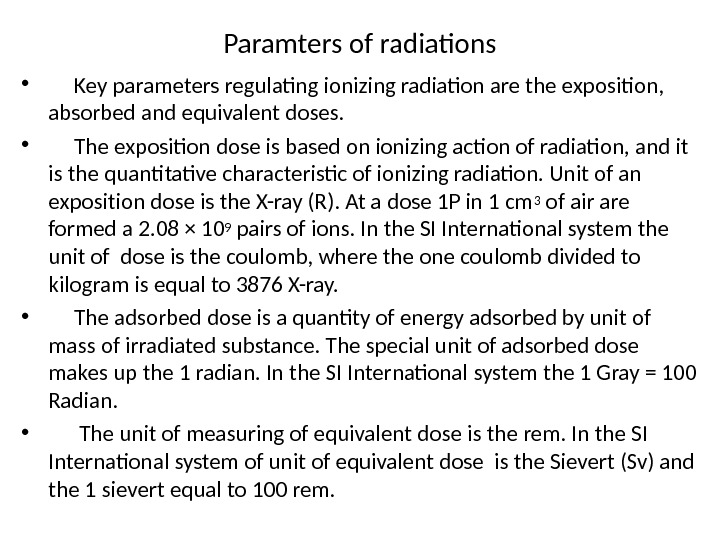
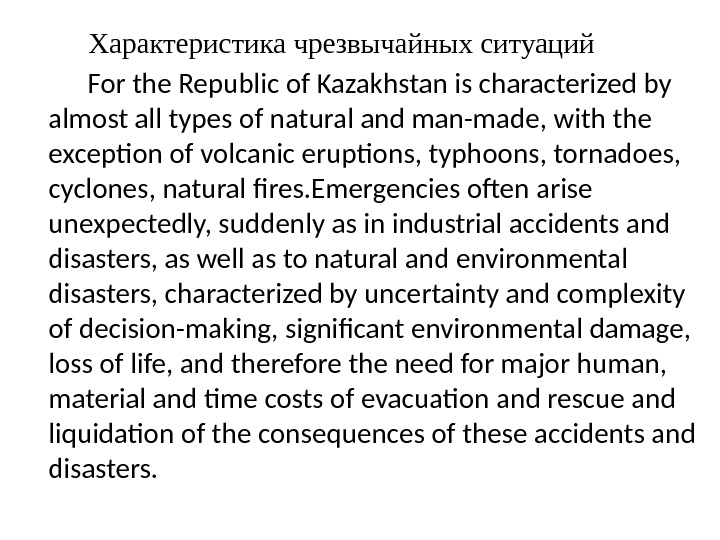
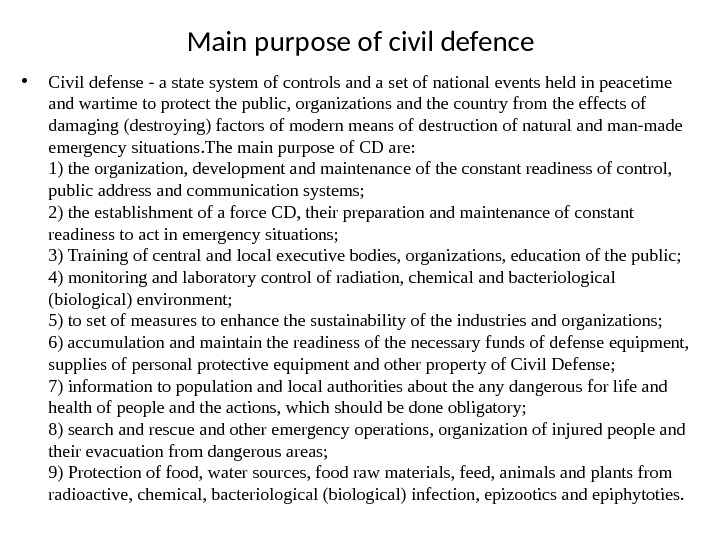
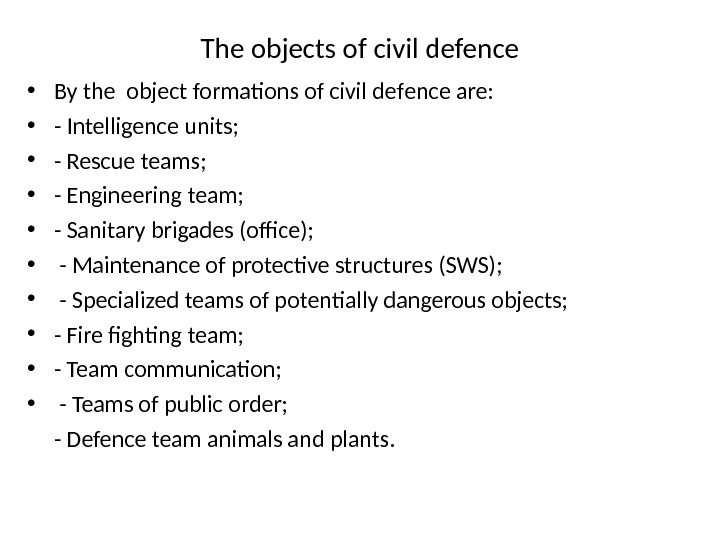
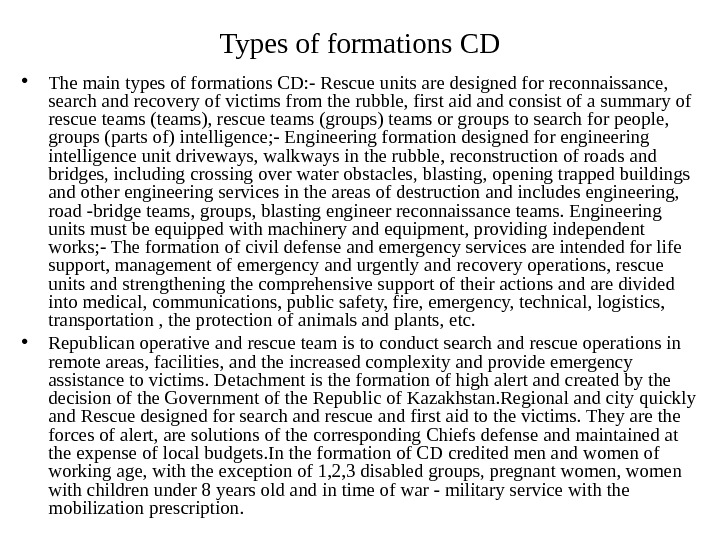
lecture_11_emergency_situation.ppt
- Размер: 299 Кб
- Количество слайдов: 14
Описание презентации The principles of providing safety of population and по слайдам
 The principles of providing safety of population and territory in emergency of peace and war time Classification of emergensy of peace time
The principles of providing safety of population and territory in emergency of peace and war time Classification of emergensy of peace time
 Basic concepts and classification of the causes of disasters • The emergency it is a violation of the normal condition of life activity of humans on certain territory, caused by accidents, catastrophe, natural or ecological disasters, as well as mass diseases by infection that leads to loss of humans or material values. • Modern representations, proposed by the World Health Organization, the emergency events with death or with deadly defeat of 10 which had been injured and requires a emergency care, is accepted to call a catastrophes. • In conformity with assertion of V. I. Vernadsky the ecological catastrophe of local and global character occurs in result of human activity. That is why in basis of emergency situations lies the disbalance between activity of human and by environmemt. In Particular we can call the doctrine of Noosphere — pollution on a large scale of atmosphere led to the global ecological catastrophe , to the so-called global warming of climate. Hence, we can see that in particular in most emergencies lies an imbalance between by reasonable approach in using of natural richness and by environment , that is to say the non-regulated human impact on large-scale processes in nature can lead to a global catastrophe.
Basic concepts and classification of the causes of disasters • The emergency it is a violation of the normal condition of life activity of humans on certain territory, caused by accidents, catastrophe, natural or ecological disasters, as well as mass diseases by infection that leads to loss of humans or material values. • Modern representations, proposed by the World Health Organization, the emergency events with death or with deadly defeat of 10 which had been injured and requires a emergency care, is accepted to call a catastrophes. • In conformity with assertion of V. I. Vernadsky the ecological catastrophe of local and global character occurs in result of human activity. That is why in basis of emergency situations lies the disbalance between activity of human and by environmemt. In Particular we can call the doctrine of Noosphere — pollution on a large scale of atmosphere led to the global ecological catastrophe , to the so-called global warming of climate. Hence, we can see that in particular in most emergencies lies an imbalance between by reasonable approach in using of natural richness and by environment , that is to say the non-regulated human impact on large-scale processes in nature can lead to a global catastrophe.
 The global warming of climate • In present day the activity of human significantly influence to composition of the air and leads to greenhouse effect, that is to say to increasing of content therein the greenhouse gases. Increase the CO 2 in atmospheric air is shown on the pictire 1. Increasing in atmosphere the greenhouse gases can lead in 2025 year warming the climate on 2 C and in this case the sea level is raised on 200 mm. The rising of level of sea’s surface leads to serious problems with flooding of many countries as Amsterdam, Petersburg, Rio-de-Janeiro etc.
The global warming of climate • In present day the activity of human significantly influence to composition of the air and leads to greenhouse effect, that is to say to increasing of content therein the greenhouse gases. Increase the CO 2 in atmospheric air is shown on the pictire 1. Increasing in atmosphere the greenhouse gases can lead in 2025 year warming the climate on 2 C and in this case the sea level is raised on 200 mm. The rising of level of sea’s surface leads to serious problems with flooding of many countries as Amsterdam, Petersburg, Rio-de-Janeiro etc.
 Basic concepts in disasters • High industrial development of modern society, providing a solution to problems in economics and wealth, while causes negative effects associated with the accident rate of production and as a result — severe consequences of environmental degradation. Continues to inflict great harm to natural hazards and disasters. In connection with this important social value has prevention, prediction and mitigation of emergencies arising from accidents, natural and environmental disasters. Act «On emergency situations of natural and man-made» from 07. 05. 1996, the regulating social relations in the republic for the prevention and elimination of emergency situations of natural and man-made Emergency situation — the situation in a particular area, resulting from accident, natural disaster or accident, which resulted or may result in loss of life, damage to their health, environment and facilities management, significant financial loss and breach of conditions of the population. The main indicator of the severity of the emergency is destructive processes, for which the normalization requires additional capabilities and adoption of extraordinary solutions.
Basic concepts in disasters • High industrial development of modern society, providing a solution to problems in economics and wealth, while causes negative effects associated with the accident rate of production and as a result — severe consequences of environmental degradation. Continues to inflict great harm to natural hazards and disasters. In connection with this important social value has prevention, prediction and mitigation of emergencies arising from accidents, natural and environmental disasters. Act «On emergency situations of natural and man-made» from 07. 05. 1996, the regulating social relations in the republic for the prevention and elimination of emergency situations of natural and man-made Emergency situation — the situation in a particular area, resulting from accident, natural disaster or accident, which resulted or may result in loss of life, damage to their health, environment and facilities management, significant financial loss and breach of conditions of the population. The main indicator of the severity of the emergency is destructive processes, for which the normalization requires additional capabilities and adoption of extraordinary solutions.
 Internal and external factors in appearance of emergencies • The basis disaster are the internal and external factors: — Internal: the complexity of technology, lack of qualified staff, design defects, wear and tear of equipment, low labor and technological discipline, etc. ; — External: natural disasters, unexpected removal of the electric power, gas, water, technology products, terrorism, war, etc. The basis disaster are the internal and external factors: — Internal: the complexity of technology, lack of qualified staff, design defects, physical and moral deterioration of equipment, low labor and technological discipline, etc. ; — External: natural disasters, unexpected removal of the electric power, gas, water, technology products, terrorism, war, etc. Analysis of the causes and course of emergencies of various kinds shows their common — stage. There are five stages of an emergency: — Accumulation of negative effects (the birth); — The period of development (initiation); — Extreme period (climax), in which the bulk of the energy is released; — A period of decay (the action of the residual and secondary damaging factors); — Liquidation of consequences of emergencies.
Internal and external factors in appearance of emergencies • The basis disaster are the internal and external factors: — Internal: the complexity of technology, lack of qualified staff, design defects, wear and tear of equipment, low labor and technological discipline, etc. ; — External: natural disasters, unexpected removal of the electric power, gas, water, technology products, terrorism, war, etc. The basis disaster are the internal and external factors: — Internal: the complexity of technology, lack of qualified staff, design defects, physical and moral deterioration of equipment, low labor and technological discipline, etc. ; — External: natural disasters, unexpected removal of the electric power, gas, water, technology products, terrorism, war, etc. Analysis of the causes and course of emergencies of various kinds shows their common — stage. There are five stages of an emergency: — Accumulation of negative effects (the birth); — The period of development (initiation); — Extreme period (climax), in which the bulk of the energy is released; — A period of decay (the action of the residual and secondary damaging factors); — Liquidation of consequences of emergencies.
 Classification of emergencies • Each emergency situation has the own reasons inherent only to them and they can be classified on the following signs: • Table 1 Classification of emergencies By departmental belonging On the field of On the prevalence The speed of the spread of dangerous — Construction anthropogenic origin -of the object Sudden quick-spreading risk Industry Natural character local Spreading a moderate speed The housing and domestic sphere Environmental regional With a slow spreading speed Transport Man-made global Agriculture Social origin Forestry Transport communications
Classification of emergencies • Each emergency situation has the own reasons inherent only to them and they can be classified on the following signs: • Table 1 Classification of emergencies By departmental belonging On the field of On the prevalence The speed of the spread of dangerous — Construction anthropogenic origin -of the object Sudden quick-spreading risk Industry Natural character local Spreading a moderate speed The housing and domestic sphere Environmental regional With a slow spreading speed Transport Man-made global Agriculture Social origin Forestry Transport communications
 Natural emergencies • To natural emergencies include: — Geophysical hazards (earthquakes, volcanic eruptions); — Geological hazards (landslides, avalanches, landslides); — Meteorological and agro-meteorological hazards (hurricanes, tornadoes, drought, extreme cold, etc. ); — Marine hydrological hazards (strong sea level fluctuations, the pressure of the ice, etc. ); — Hydrological hazards (floods, raising the water table); — Natural fires (forest, desert, peat); — Infectious diseases of people (epidemic); — Infectious diseases of farm animals (epizootic); — Damage to crop diseases and pests (epiphytoty).
Natural emergencies • To natural emergencies include: — Geophysical hazards (earthquakes, volcanic eruptions); — Geological hazards (landslides, avalanches, landslides); — Meteorological and agro-meteorological hazards (hurricanes, tornadoes, drought, extreme cold, etc. ); — Marine hydrological hazards (strong sea level fluctuations, the pressure of the ice, etc. ); — Hydrological hazards (floods, raising the water table); — Natural fires (forest, desert, peat); — Infectious diseases of people (epidemic); — Infectious diseases of farm animals (epizootic); — Damage to crop diseases and pests (epiphytoty).
 Technological emergencies • By technogenic emergencies include: — Industrial; — Transport accident (crash rail trains, marine and river vessels, plane crashes, car crashes (accident), accident on the main pipelines); — Fire (explosion); — Accident with ejection (threatened release); — Accident with ejection (threat output); — Accident with ejection (threatened release) biological hazards; — The sudden collapse of buildings; — Failure on power systems; — Accident on utility networks livelihoods; — Accidents in plants; — Hydrodynamic accident (dam failure, dams).
Technological emergencies • By technogenic emergencies include: — Industrial; — Transport accident (crash rail trains, marine and river vessels, plane crashes, car crashes (accident), accident on the main pipelines); — Fire (explosion); — Accident with ejection (threatened release); — Accident with ejection (threat output); — Accident with ejection (threatened release) biological hazards; — The sudden collapse of buildings; — Failure on power systems; — Accident on utility networks livelihoods; — Accidents in plants; — Hydrodynamic accident (dam failure, dams).
 Dangerous radiation objects • Dangerous radioactive objects use in their work the sources of ionizing radiation. In present day in world more than in 30 countries are using about 450 nuclear power plants. Except danger which create the nuclear power plant, there are still many real sources of radioactive co ntam i nation. It is necessary to note that Kazakhstan on production of uranium wins first place in the world. Therefore it is actual in Kazakhstan. • The major striking factors of radiation emissions are: 1) impact of external radiation — gamma, a beta and alpha radiations; 2) internal radiation from the radionuclides which have got to a human body — an alpha and a beta radiation; 3) a combination of radiating which are influencing at the expense of external and internal radiations. After accident, the basic source of dangerous radiation represents the external irradiation. Here inhalation receipt of radionuclides is almost excluded at the correct and timely application of means of protection of respiratory organs. Internal radiation develops as a result of receipt of radionuclides in an organism with food and with water. In first days after accident most danger represents the isotopes of iodine. Via 2 — 3 month after accident the basic agent of irradiation becomes the radioactive cesium. •
Dangerous radiation objects • Dangerous radioactive objects use in their work the sources of ionizing radiation. In present day in world more than in 30 countries are using about 450 nuclear power plants. Except danger which create the nuclear power plant, there are still many real sources of radioactive co ntam i nation. It is necessary to note that Kazakhstan on production of uranium wins first place in the world. Therefore it is actual in Kazakhstan. • The major striking factors of radiation emissions are: 1) impact of external radiation — gamma, a beta and alpha radiations; 2) internal radiation from the radionuclides which have got to a human body — an alpha and a beta radiation; 3) a combination of radiating which are influencing at the expense of external and internal radiations. After accident, the basic source of dangerous radiation represents the external irradiation. Here inhalation receipt of radionuclides is almost excluded at the correct and timely application of means of protection of respiratory organs. Internal radiation develops as a result of receipt of radionuclides in an organism with food and with water. In first days after accident most danger represents the isotopes of iodine. Via 2 — 3 month after accident the basic agent of irradiation becomes the radioactive cesium. •
 Paramters of radiations • Key parameters regulating ionizing radiation are the exposition, absorbed and equivalent doses. • The exposition dose is based on ionizing action of radiation, and it is the quantitative characteristic of ionizing radiation. Unit of an exposition dose is the X-ray (R). At a dose 1 Р in 1 cm 3 of air are formed a 2. 08 × 10 9 pairs of ions. In the SI International system the unit of dose is the coulomb, where the one coulomb divided to kilogram is equal to 3876 X-ray. • The adsorbed dose is a quantity of energy adsorbed by unit of mass of irradiated substance. The special unit of adsorbed dose makes up the 1 radian. In the SI International system the 1 Gray = 100 Radian. • The unit of measuring of equivalent dose is the rem. In the SI International system of unit of equivalent dose is the Sievert (Sv) and the 1 sievert equal to 100 rem.
Paramters of radiations • Key parameters regulating ionizing radiation are the exposition, absorbed and equivalent doses. • The exposition dose is based on ionizing action of radiation, and it is the quantitative characteristic of ionizing radiation. Unit of an exposition dose is the X-ray (R). At a dose 1 Р in 1 cm 3 of air are formed a 2. 08 × 10 9 pairs of ions. In the SI International system the unit of dose is the coulomb, where the one coulomb divided to kilogram is equal to 3876 X-ray. • The adsorbed dose is a quantity of energy adsorbed by unit of mass of irradiated substance. The special unit of adsorbed dose makes up the 1 radian. In the SI International system the 1 Gray = 100 Radian. • The unit of measuring of equivalent dose is the rem. In the SI International system of unit of equivalent dose is the Sievert (Sv) and the 1 sievert equal to 100 rem.
 Характеристика чрезвычайных ситуаций For the Republic of Kazakhstan is characterized by almost all types of natural and man-made, with the exception of volcanic eruptions, typhoons, tornadoes, cyclones, natural fires. Emergencies often arise unexpectedly, suddenly as in industrial accidents and disasters, as well as to natural and environmental disasters, characterized by uncertainty and complexity of decision-making, significant environmental damage, loss of life, and therefore the need for major human, material and time costs of evacuation and rescue and liquidation of the consequences of these accidents and disasters.
Характеристика чрезвычайных ситуаций For the Republic of Kazakhstan is characterized by almost all types of natural and man-made, with the exception of volcanic eruptions, typhoons, tornadoes, cyclones, natural fires. Emergencies often arise unexpectedly, suddenly as in industrial accidents and disasters, as well as to natural and environmental disasters, characterized by uncertainty and complexity of decision-making, significant environmental damage, loss of life, and therefore the need for major human, material and time costs of evacuation and rescue and liquidation of the consequences of these accidents and disasters.
 Main purpose of civil defence • Civil defense — a state system of controls and a set of national events held in peacetime and wartime to protect the public, organizations and the country from the effects of damaging (destroying) factors of modern means of destruction of natural and man-made emergency situ ations. The main purpose of CD are: 1) the organization, development and maintenance of the constant readiness of control, public address and communication systems; 2) the establishment of a force CD, their preparation and maintenance of constant readiness to act in emergency situations; 3) Training of central and local executive bodies, organizations, education of the public; 4) monitoring and laboratory control of radiation, chemical and bacteriological (biological) environment; 5) to set of measures to enhance the sustainability of the industries and organizations; 6) accumulation and maintain the readiness of the necessary funds of defense equipment, supplies of personal protective equipment and other property of Civil Defense; 7) information to population and local authorities about the any dangerous for life and health of people and the actions, which should be done obligatory; 8) search and rescue and other emergency operations, organization of injured people and their evacuation from dangerous areas; 9) Protection of food, water sources, food raw materials, feed, animals and plants from radioactive, chemical, bacteriological (biological) infection, epizootics and epiphytoties.
Main purpose of civil defence • Civil defense — a state system of controls and a set of national events held in peacetime and wartime to protect the public, organizations and the country from the effects of damaging (destroying) factors of modern means of destruction of natural and man-made emergency situ ations. The main purpose of CD are: 1) the organization, development and maintenance of the constant readiness of control, public address and communication systems; 2) the establishment of a force CD, their preparation and maintenance of constant readiness to act in emergency situations; 3) Training of central and local executive bodies, organizations, education of the public; 4) monitoring and laboratory control of radiation, chemical and bacteriological (biological) environment; 5) to set of measures to enhance the sustainability of the industries and organizations; 6) accumulation and maintain the readiness of the necessary funds of defense equipment, supplies of personal protective equipment and other property of Civil Defense; 7) information to population and local authorities about the any dangerous for life and health of people and the actions, which should be done obligatory; 8) search and rescue and other emergency operations, organization of injured people and their evacuation from dangerous areas; 9) Protection of food, water sources, food raw materials, feed, animals and plants from radioactive, chemical, bacteriological (biological) infection, epizootics and epiphytoties.
 T h e objects of civil defence • By the object formations of civil def ence are: • — Intelligence units; • — Rescue teams; • — Engineering team; • — Sanitary brigades (office); • — Maintenance of protective structures (SWS); • — Specialized teams of potentially dangerous objects; • — Fire fighting team; • — Team communication; • — Teams of public order; — D efence team animals and plants.
T h e objects of civil defence • By the object formations of civil def ence are: • — Intelligence units; • — Rescue teams; • — Engineering team; • — Sanitary brigades (office); • — Maintenance of protective structures (SWS); • — Specialized teams of potentially dangerous objects; • — Fire fighting team; • — Team communication; • — Teams of public order; — D efence team animals and plants.
 Types of formations CD • The main types of formations CD: — Rescue units are designed for reconnaissance, search and recovery of victims from the rubble, first aid and consist of a summary of rescue teams (teams), rescue teams (groups) teams or groups to search for people, groups (parts of) intelligence; — Engineering formation designed for engineering intelligence unit driveways, walkways in the rubble, reconstruction of roads and bridges, including crossing over water obstacles, blasting, opening trapped buildings and other engineering services in the areas of destruction and includes engineering, road -bridge teams, groups, blasting engineer reconnaissance teams. Engineering units must be equipped with machinery and equipment, providing independent works; — The formation of civil defense and emergency services are intended for life support, management of emergency and urgently and recovery operations, rescue units and strengthening the comprehensive support of their actions and are divided into medical, communications, public safety, fire, emergency, technical, logistics, transportation , the protection of animals and plants, etc. • Republican operative and rescue team is to conduct search and rescue operations in remote areas, facilities, and the increased complexity and provide emergency assistance to victims. Detachment is the formation of high alert and created by the decision of the Government of the Republic of Kazakhstan. Regional and city quickly and Rescue designed for search and rescue and first aid to the victims. They are the forces of alert, are solutions of the corresponding Chiefs defense and maintained at the expense of local budgets. In the formation of CD credited men and women of working age, with the exception of 1, 2, 3 disabled groups, pregnant women, women with children under 8 years old and in time of war — military service with the mobilization prescription.
Types of formations CD • The main types of formations CD: — Rescue units are designed for reconnaissance, search and recovery of victims from the rubble, first aid and consist of a summary of rescue teams (teams), rescue teams (groups) teams or groups to search for people, groups (parts of) intelligence; — Engineering formation designed for engineering intelligence unit driveways, walkways in the rubble, reconstruction of roads and bridges, including crossing over water obstacles, blasting, opening trapped buildings and other engineering services in the areas of destruction and includes engineering, road -bridge teams, groups, blasting engineer reconnaissance teams. Engineering units must be equipped with machinery and equipment, providing independent works; — The formation of civil defense and emergency services are intended for life support, management of emergency and urgently and recovery operations, rescue units and strengthening the comprehensive support of their actions and are divided into medical, communications, public safety, fire, emergency, technical, logistics, transportation , the protection of animals and plants, etc. • Republican operative and rescue team is to conduct search and rescue operations in remote areas, facilities, and the increased complexity and provide emergency assistance to victims. Detachment is the formation of high alert and created by the decision of the Government of the Republic of Kazakhstan. Regional and city quickly and Rescue designed for search and rescue and first aid to the victims. They are the forces of alert, are solutions of the corresponding Chiefs defense and maintained at the expense of local budgets. In the formation of CD credited men and women of working age, with the exception of 1, 2, 3 disabled groups, pregnant women, women with children under 8 years old and in time of war — military service with the mobilization prescription.
